Season two of Daredevil will introduce Elektra, the Greek assassin who’s Matt Murdock’s lover and sometime adversary. Her creator, Frank Miller, has told interviewers that the show could never bring his vision of Elektra to life. And he’s right — because no one could ever match the mindbending absurdist nightmare that Miller conjured in his seminal work on the character, Elektra: Assassin.
The moment of “Peak Miller” — the instant at which Frank Miller transformed from legendary comics genius to the self-aware (and still genius) madman who’s responsible for some of the hottest messes in comics history — is difficult to pin down.
To some, Peak Miller began with the awful hilarity that is All-Star Batman and Robin. To others, it began more recently, with his horrifyingly misguided post-9/11 superhero series, Holy Terror. To others, Peak Miller started to arrive the moment he returned to the Dark Knight well with The Dark Knight Strikes Again.
But I’d argue Peak Miller arrived much, much earlier. It started in August 1986, when he wrote Elektra: Assassin, an eight-part series that truly represents the amazing blend of trenchant commentary and complete mindscrewing that would define his later infamous work.
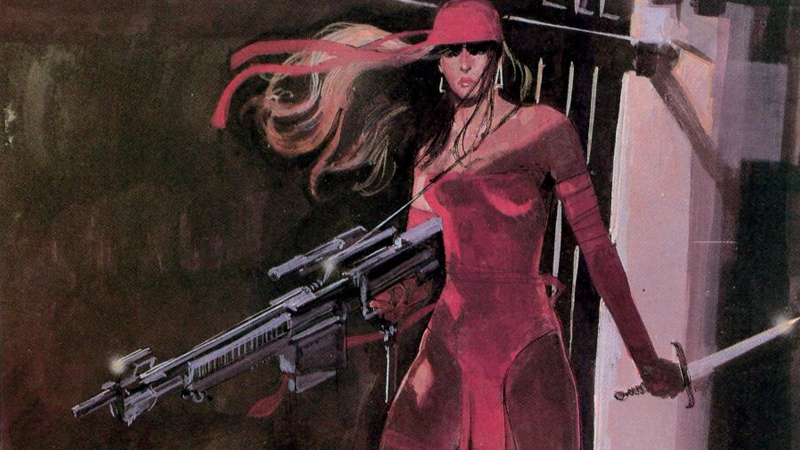
If you attempted to describe Elektra: Assassin, it’s ostensibly about Elektra the hitwoman on her own — separated from the Hand Clan, Matt Murdock and the other trappings that largely defined her appearances in the 1980s in Daredevil. Instead, we find the Grecian assassin on the trail of leftist US Presidential nominee Ken Wind. He’s been possessed by a nefarious demon called the Beast — a creature that wants to start a nuclear war. Elektra and her sometimes ally, sometimes opponent, SHIELD Agent Garrett, have to hunt down Wind and stop the Beast before it can destroy the world.
Now, throw all of that information out the window — because you’re not going to read Elektra: Assassin for its plot. You’re going to read it as a trippy fever dream, a winding commentary on sex, politics, comics, hell, even Frank Miller himself. It’s a trip through the troubled mind of Elektra, but equally a journey into Miller’s own psyche that never lets up, even in its quieter moments.
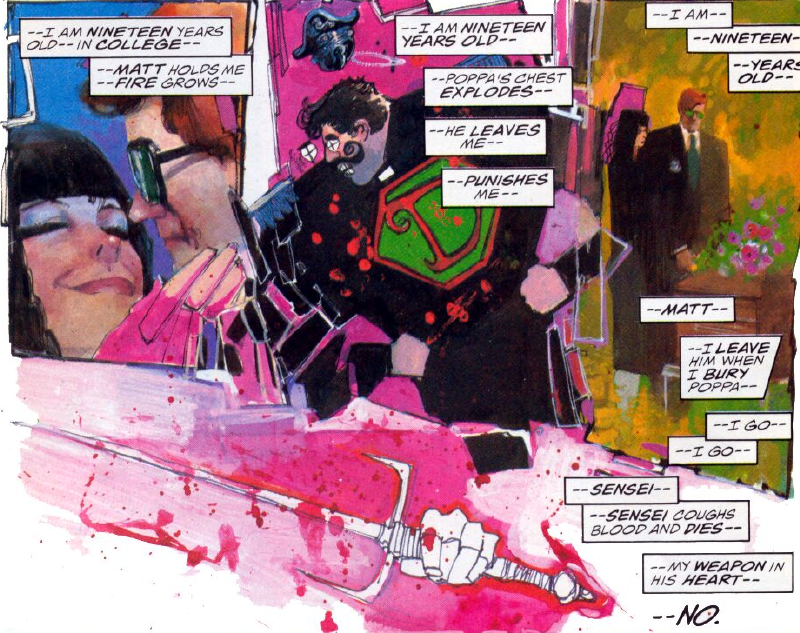
It can be painfully hard to follow at some points — the first two issues in particular, which largely re-establish Elektra’s origins and set up the concept of the Beast. The opening issues accomplish these things via a reality-warping dash through Elektra’s mind, panels flickering by with random insights like neurons firing through the brain.
Even in its more coherent moments, Assassin is psychedelic, with one foot in reality and the other firmly rooted in the psyches of Elektra and Garrett — which is really how you end up not caring a jot about the plot, and instead focus on the commentary Miller provides about his chosen topics.
It’s hard to capture who Miller’s Elektra really is in Assassin. Despite Elektra essentially being the narrator of the series alongside Garrett, it all blurs into Miller’s own beliefs and debates. You’re essential engaging with an eight-issue-long Frank Miller essay, occasionally punctured by shots of an Elektra comic book that barely makes sense.
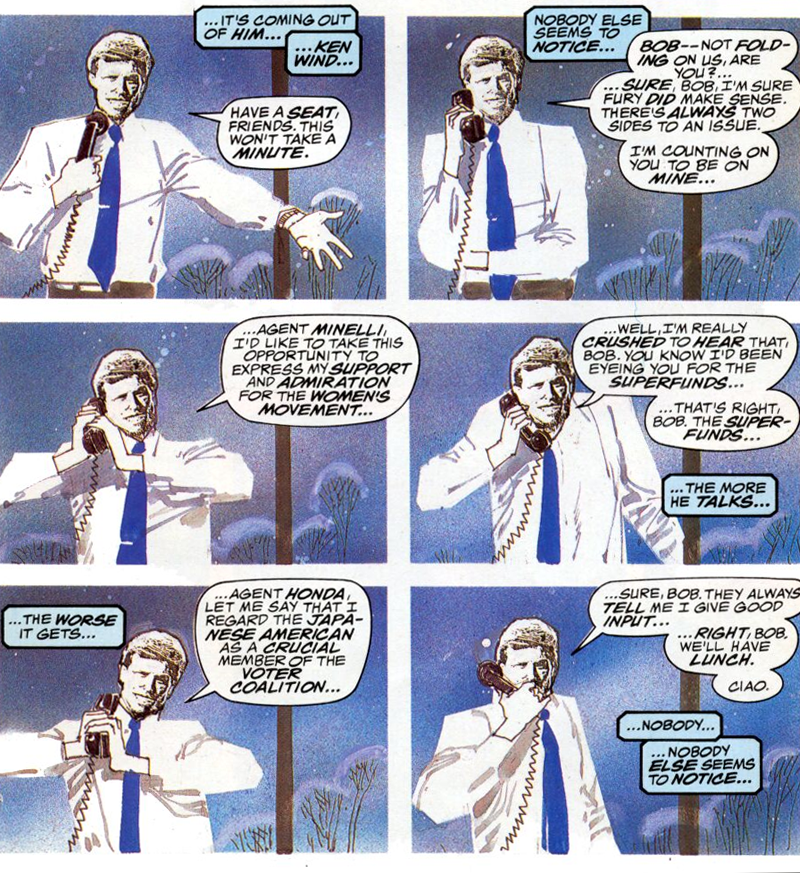
Everything in Elektra: Assassin is exaggerated and pushed to its most extreme. And Miller’s commentary, which has all the subtlety of a 10-tonne-weight repeatedly smashed into your face, is no exception. It gets to the point that some times you’re honestly not sure if Miller and Siekiewicz are engaging in deep satire, or have simply gone of the deep end into sheer theatrical absurdity.
Ken Wind, for example, is painted as the ultimate 1980s Liberal — a peace loving beatnik who lit candles at Woodstock as a youth, and is now sweeping the nation as an earnest idealist. But his veneer of smug fakery comes across in the chilling grin Sienkiewicz repeatedly sketches him with, almost like a mask — symbolic of a man spouting empty promises of political revolution. His opponent, the incumbent President who might as well be called “Smichard Smixon”, is equally painted in broad strokes: a man who throws homophobic slurs and seductively strokes the nuclear launch button like a lover.
A similarly unsubtle dichotomy can be found in how Miller uses Elektra and Agent Garrett to satirize the popular trends of modern comics — and in particular, weirdly enough, two trends that Miller himself arguably pioneered with his work on Daredevil and The Dark Knight Returns. Elektra and the Hand both represent how stereotypical Comic Book Ninjas had become by the mid ’80s (after Miller had made them popular!). So the outlandish beast and the Hand assassins that chase Elektra and Garret in the latter half of the series are frequently described as absurd, almost comical figures, out of place and not even remotely threatening to either character.
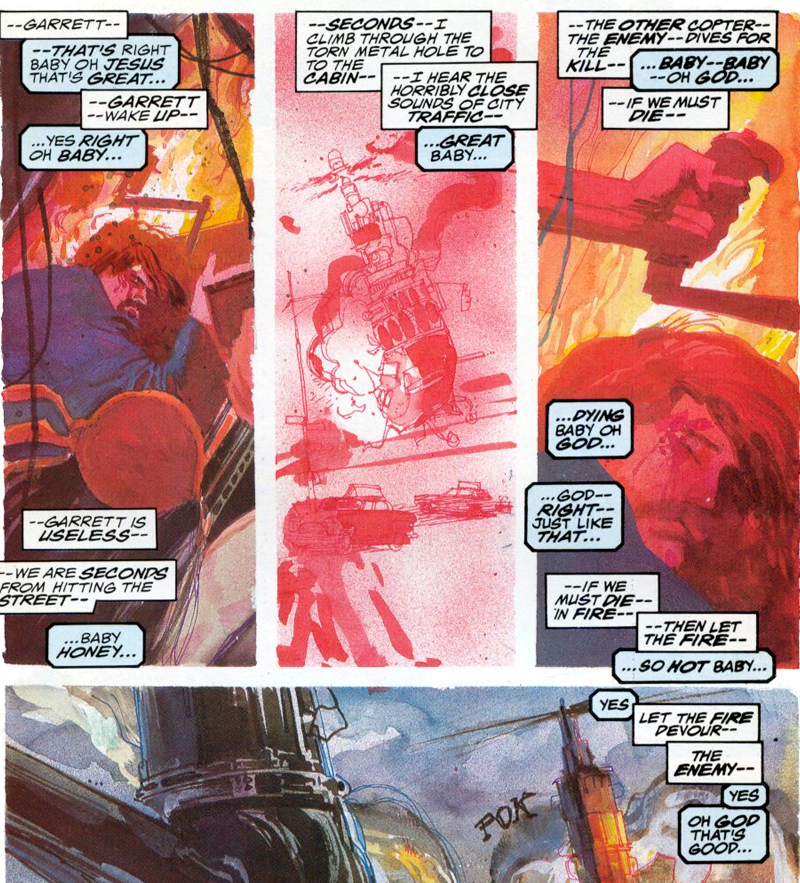
For reference, narration associated with Elektra is in the white boxes, Garrett in the blue.
Garrett, and his SHIELD partner Perry, are both pastiches of hyperviolent, excessively grim action comics. Agent Garrett is a vile, foulmouthed misogynist, who’s constantly aroused and angered by Elektra’s sexually provocative nature (as well as her mind-altering psychic powers). Some of his later dialogues with Elektra seem to be reaching an almost pornographic climax. He gets himself into gory, violent fights through the book, that leave him in literal pieces, having to be stitched back together by SHIELD’s cybernetics division again and again. So he’s essentially a killer robot with a human mind by the end of the story.
Perry himself is taken even further than Garrett — who at least realises that Elektra is right about Ken Wind and the threat of the Beast and becomes a vague semblance of a “hero”. Perry becomes a similarly cybernetic, unhinged agent of the Beast, after Elektra kills him by shoving a bayonet up his backside. That alone should be enough to tell you about the level of excessive violence in the book, which borders on parody in its own right.
But there’s another interesting mirror between Elektra and Garrett, in the way their violence is depicted. Elektra’s killing is as graceful as it is brutal, emblematic of the exotic ninja stereotype, while Garrett’s violence is senseless, gore-and-explosion laden machismo, typical of over-the-top action movies.
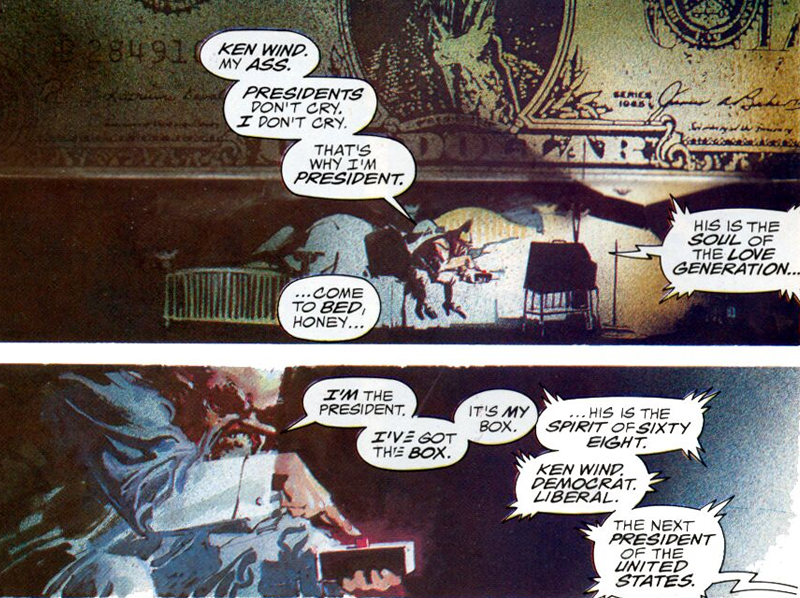
Elektra: Assassin would devolve utterly into an spectacular, Frank-Miller-patented mess, however, if not for the incredible talents of Bill Sienkiewicz. The artist is at the heights of his power, and his watercolour work is perfect for a series as trippy as Elektra: Assassin — an aesthetic unlike anything in comics at the time, matched to a script that equally unique.
Take the disconcertingly smug face (constantly staring out of the panel) that he gives Ken Wind. Or the trippy visuals he paints for sequences inside Elektra’s mind, where people transform into animals or garish, exaggerated caricatures. Or even how how he transmogrifies Elektra herself, depending on whose perspective we are seeing her from. Every panel is dripping with style, and Siekiewicz’ esoteric visuals are the absolute perfect frame for Miller to build his words inside (there’s a fabled tale about Elektra: Assassin that says Siekiewicz just painted random pages as he liked, and when Miller received them, he’d re-arrange them as he saw fit, which honestly wouldn’t surprise me).
But in spite of all of this — the jaw-dropping art, the fine line between cutting satire and just a complete descent into madness, the insane violence, the crass unsubtle nature of it all — Elektra: Assassin remains a transformative work, not just for the character, but for Marvel’s approach to adult graphic comic work.
Assassin got into Elektra’s head. And instead of focused on her as a ninja, or her history within Miller’s Daredevil run, it delved into her psychic powers — something that doesn’t really get touched on a lot, elsewhere. Miller’s masterful use of them on his warped fever dream journey across the series gives us a unique, bizarrely personal insight into Elektra that we’d never seen before, and haven’t really seen since. It’s a version of the character that could never have been done in the mainstream Marvel universe.
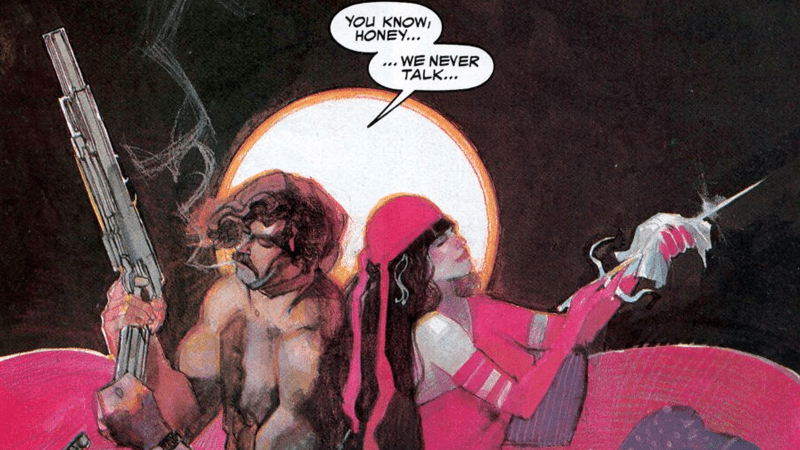
On top of that, Assassin broke boundaries at Marvel for its content — or more specifically, at its imprint, Epic. It was far too adult for the main company to release. Its gore, its sexuality, it’s language, even Siekiewicz’s watercolour art — it was like nothing that had ever been released with Marvel’s name before. Some aspects of it, especially the characterisation of Garrett, look shockingly puerile in modern contexts. But as the ’90s gave way to an edgy era of adolescent “maturity”, Elektra Assassin‘s unique brand of wildness, trying to balance biting cultural commentary with ridiculous pastiche, essentially lead the way for truly mature Marvel work like Alias to flourish later on.
Frank Miller was the bizarre, unfathomable hammer, that smashed open that wall. Thus allowing books like Alias to guide themselves more delicately through to the other side of adult-themed comics from a mainstream comic publisher. And Miller accomplished this by delving deeply into the mind of one of his most iconic creations, and digging up something truly memorable… for all the right and wrong reasons.

Comments
One response to “Frank Miller’s Elektra: Assassin Is A Hot Mess, But It’s A Beautiful Hot Mess”
Unreadable. Miller is too much wank to handle at the best of times.